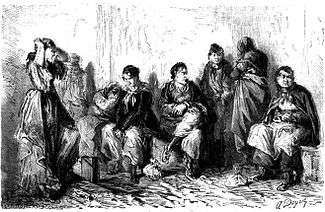Pétroleuses
- For the 1971 film Les Pétroleuses, see The Legend of Frenchie King.

Pétroleuses were, according to popular rumours at the time, female supporters of the Paris Commune, accused of burning down much of Paris during the last days of the Commune in May 1871. During May, when Paris was being recaptured by loyalist Versaillais troops, rumours circulated that lower-class women were committing arson against private property and public buildings, using bottles full of petroleum or paraffin (similar to modern-day Molotov cocktails) which they threw into cellar windows, in a deliberate act of spite against the government. Many Parisian buildings, including the Hôtel de Ville the Tuileries Palace, the Palais de Justice and many other government buildings were in fact set afire by the soldiers of the Commune during the last days of the Commune, prompting the press and Parisian public opinion to blame the pétroleuses.[1]
The history of the Paris Commune by Maxime Du Camp, written in the 1870s, and more recent research by historians of the Paris Commune, including Robert Tombs and Gay Gullickson, concluded that there were no incidents of deliberate arson by pétroleuses. Of the thousands of suspected pro-Communard women tried in Versailles after the Commune ended, only a handful were convicted of any crimes, and their convictions were based on activity such as shooting at loyalist troops. Official trial records show that no women were ever convicted of arson, and that accusations of the crime were quickly shown to have no basis. The buildings destroyed at the end of the Commune were not burned down by pétroleuses, but by the soldiers of the Commune. The Hôtel de Ville, the Palais de Justice, the Tuileries Palace and other government buildings and symbols of authority were burned by Commune forces as they retreated. Some buildings along the Rue de Rivoli were burned down during street-fighting between Communards and Versaillais troops. Gullickson suggests that the myth of the pétroleuses was part of a propaganda campaign by Versaillais politicians, who portrayed Parisian women in the Commune as unnatural, destructive, and barbaric, giving loyalist forces a moral victory over the "unnatural" Communards.
Despite this, the myth of pétroleuses was widely believed until the twentieth century. In Paris itself, the sale of flammable liquids was banned for several months after the end of the Commune (a measure taken again during the 2005 riots, when 8,973 cars were set afire by arsonists in the Paris suburbs and other French cities).
References
- Robert Tombs, The War Against Paris: 1871, Cambridge University Press, 1981, 272 pages ISBN 978-0-521-28784-5
- Gay Gullickson, Unruly Women of Paris, Cornell Univ Press, 1996, 304 pages ISBN 978-0-8014-8318-9
- Rougerie, Jacques, La Commune de 1871, (1988), Presses Universitaires de France, ISBN 978-2-13-062078-5.
Notes and citations
- ↑ Rougerie, Jacques, La Commune de 1871, Presses Universitaires de France, (1988), p. 117.